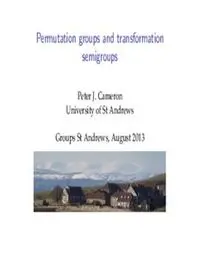
Permutation groups and transformation semigroups PDF
Preview Permutation groups and transformation semigroups
Permutation groups and transformation semigroups Peter J. Cameron University of St Andrews Groups St Andrews, August 2013 If a semigroup has a large group of units, we can apply group theory to it. But there may not be any units at all! One area where our chances are better is the theory of transformation semigroups, i.e. semigroups of mappings Ω → Ω (subsemigroups of the full transformation semigroup T(Ω)). In a transformation semigroup G, the units are the permutations; if there are any, they form a permutation group G. Even if there are no units, we have a group to play with, the normaliser of S in Sym(Ω), the set of all permutations g such −1 that g Sg = S. Groups and semigroups How can group theory help the study of semigroups? One area where our chances are better is the theory of transformation semigroups, i.e. semigroups of mappings Ω → Ω (subsemigroups of the full transformation semigroup T(Ω)). In a transformation semigroup G, the units are the permutations; if there are any, they form a permutation group G. Even if there are no units, we have a group to play with, the normaliser of S in Sym(Ω), the set of all permutations g such −1 that g Sg = S. Groups and semigroups How can group theory help the study of semigroups? If a semigroup has a large group of units, we can apply group theory to it. But there may not be any units at all! Groups and semigroups How can group theory help the study of semigroups? If a semigroup has a large group of units, we can apply group theory to it. But there may not be any units at all! One area where our chances are better is the theory of transformation semigroups, i.e. semigroups of mappings Ω → Ω (subsemigroups of the full transformation semigroup T(Ω)). In a transformation semigroup G, the units are the permutations; if there are any, they form a permutation group G. Even if there are no units, we have a group to play with, the normaliser of S in Sym(Ω), the set of all permutations g such −1 that g Sg = S. Acknowledgment It was Joa˜o Arau´ jo who got me involved in this work, and all the work of mine I report below is joint with him and possibly others. I will refer to him as JA. Theorem Let a ∈ Tn \ Sn, and let S be the semigroup generated by the −1 conjugates g ag for g ∈ Sn. Then ◮ S is idempotent-generated; ◮ S is regular; ◮ S = ⟨a, S n⟩ \ Sn. In other words, semigroups of this form, with normaliser Sn, have very nice properties! Levi–McFadden and McAlister The following is the prototype for results of this kind. Let Sn and Tn denote the symmetric group and full transformation semigroup on {1, 2, . . . , n}. In other words, semigroups of this form, with normaliser Sn, have very nice properties! Levi–McFadden and McAlister The following is the prototype for results of this kind. Let Sn and Tn denote the symmetric group and full transformation semigroup on {1, 2, . . . , n}. Theorem Let a ∈ Tn \ Sn, and let S be the semigroup generated by the −1 conjugates g ag for g ∈ Sn. Then ◮ S is idempotent-generated; ◮ S is regular; ◮ S = ⟨a, S n⟩ \ Sn. Levi–McFadden and McAlister The following is the prototype for results of this kind. Let Sn and Tn denote the symmetric group and full transformation semigroup on {1, 2, . . . , n}. Theorem Let a ∈ Tn \ Sn, and let S be the semigroup generated by the −1 conjugates g ag for g ∈ Sn. Then ◮ S is idempotent-generated; ◮ S is regular; ◮ S = ⟨a, S n⟩ \ Sn. In other words, semigroups of this form, with normaliser Sn, have very nice properties! ◮ Given a semigroup property P, for which pairs (a, G) as above does the semigroup ⟨a, G⟩ \ G have property P? ◮ For which pairs (a, G) are the semigroups of the preceding parts equal? The general problem Problem ◮ Given a semigroup property P, for which pairs (a, G), with −1 a ∈ Tn \ Sn and G ≤ Sn, does the semigroup ⟨g ag : g ∈ G⟩ have property P? ◮ For which pairs (a, G) are the semigroups of the preceding parts equal? The general problem Problem ◮ Given a semigroup property P, for which pairs (a, G), with −1 a ∈ Tn \ Sn and G ≤ Sn, does the semigroup ⟨g ag : g ∈ G⟩ have property P? ◮ Given a semigroup property P, for which pairs (a, G) as above does the semigroup ⟨a, G⟩ \ G have property P?
